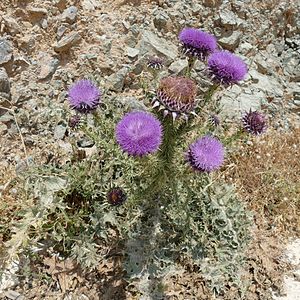Onopordum bracteatum
| Onopordum bracteatum | ||||||||||||
|---|---|---|---|---|---|---|---|---|---|---|---|---|

Onopordum bracteatum subsp. creticum |
||||||||||||
| Systematics | ||||||||||||
|
||||||||||||
| Scientific name | ||||||||||||
| Onopordum bracteatum | ||||||||||||
| Boiss. & Hero. |
Onopordum bracteatum is a plant from the genus of onopordum ( Onopordum ) in the subfamily of Carduoideae within the family of Compositae (Asteraceae).
features
Onopordum bracteatum is a two-year-old hemicryptophyte that reaches heights of 50 to 180 centimeters. The broadly winged stem has thorns up to 13 millimeters long. The basal leaves are pinnate and have lanceolate sections. The heads are short stalked and heaped at the tip of the stem. The bracts narrow more or less abruptly into a terminal mandrel. The cups have a diameter of 50 to 70 millimeters. The crown is purple and 30 to 40 millimeters in size.
The flowering period extends from June to August.
Occurrence
Onopordum bracteatum occurs in the northeastern Mediterranean region. It thrives in Turkey, Cyprus, Crete and the Aegean Sea.
Systematics
There are two subspecies :
- Onopordum bracteatum subsp. bracteatum : the plant is white wooly. The stem is bald. The wings are up to 8 millimeters wide and their end spine is up to 10 millimeters long. The end spine of the leaf lobes is up to 12 millimeters long. The upper leaves envelop the cups. The bracts are 5 to 8 millimeters wide and have a terminal spine up to 10 millimeters long. The subspecies grows on rocky floors.
- Onopordum bracteatum subsp. creticum Franco : The plant is not woolly, but greyish green. The stem wings, which are up to 12 millimeters wide, have a terminal mandrel up to 13 millimeters long. The upper side of the leaf is greyish green, while the underside is thickly whitish-tomentose. The terminal spines of the leaf lobes are up to 20 millimeters long. The leaves do not envelop the cups. The bracts are 8 to 10 millimeters wide and have a terminal spine up to 12 millimeters long. The subspecies is endemic to Crete . The number of chromosomes is 2n = 34.
It grows in oak forests, on limestone corridors, ruderal spots and sandy coasts at altitudes from 0 to 1600 meters.
Onopordum myriacanthum Boiss is no longer part of Onopordum bracteatum . (Syn .: Onopordum bracteatum subsp. Myriacanthum (Boiss.) Franco , Onopordum bracteatum subsp. Ilex (Janka) Franco ).
supporting documents
- ↑ a b c d e Ralf Jahn, Peter Schönfelder: Excursion flora for Crete . With contributions by Alfred Mayer and Martin Scheuerer. Eugen Ulmer, Stuttgart (Hohenheim) 1995, ISBN 3-8001-3478-0 , p. 325 .
- ↑ a b c Werner Greuter: Compositae (pro parte majore): Onopordum. In: Werner Greuter , Eckhard von Raab-Straube (ed.): Compositae. Euro + Med Plantbase - the information resource for Euro-Mediterranean plant diversity. Berlin 2006–2009, online.
- ^ Tropicos. [1]
- ^ J. do Amaral Franco: Onopordum. In: TG Tutin, VH Heywood, NA Burges, DM Moore, DH Valentine, SM Walters, DA Webb (eds.): Flora Europaea . Volume 4: Plantaginaceae to Compositae (and Rubiaceae) . Cambridge University Press, Cambridge 1976, ISBN 0-521-08717-1 , pp. 247 (English, limited preview in Google Book search).
Web links
- Dietmar Brandes: Notes on Onopordum bracteatum on Rhodes. Braunschweig 2009, PDF file (with images of Onopordum bracteatum subsp. Bracteatum ).
- Jean Bienvenu: Onopordum bracteatum ssp. creticum. (with pictures of Onopordum bracteatum subsp. creticum ).
